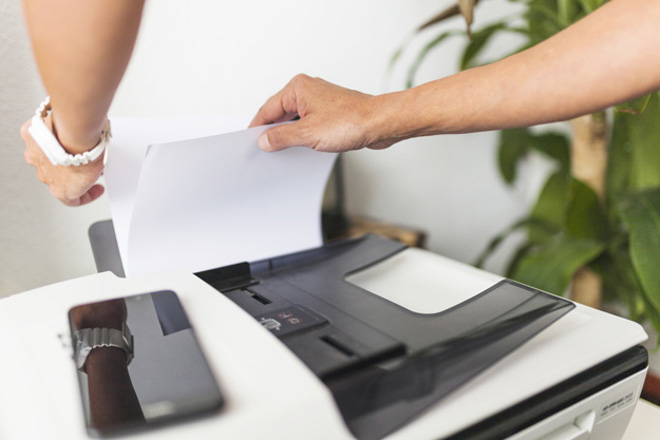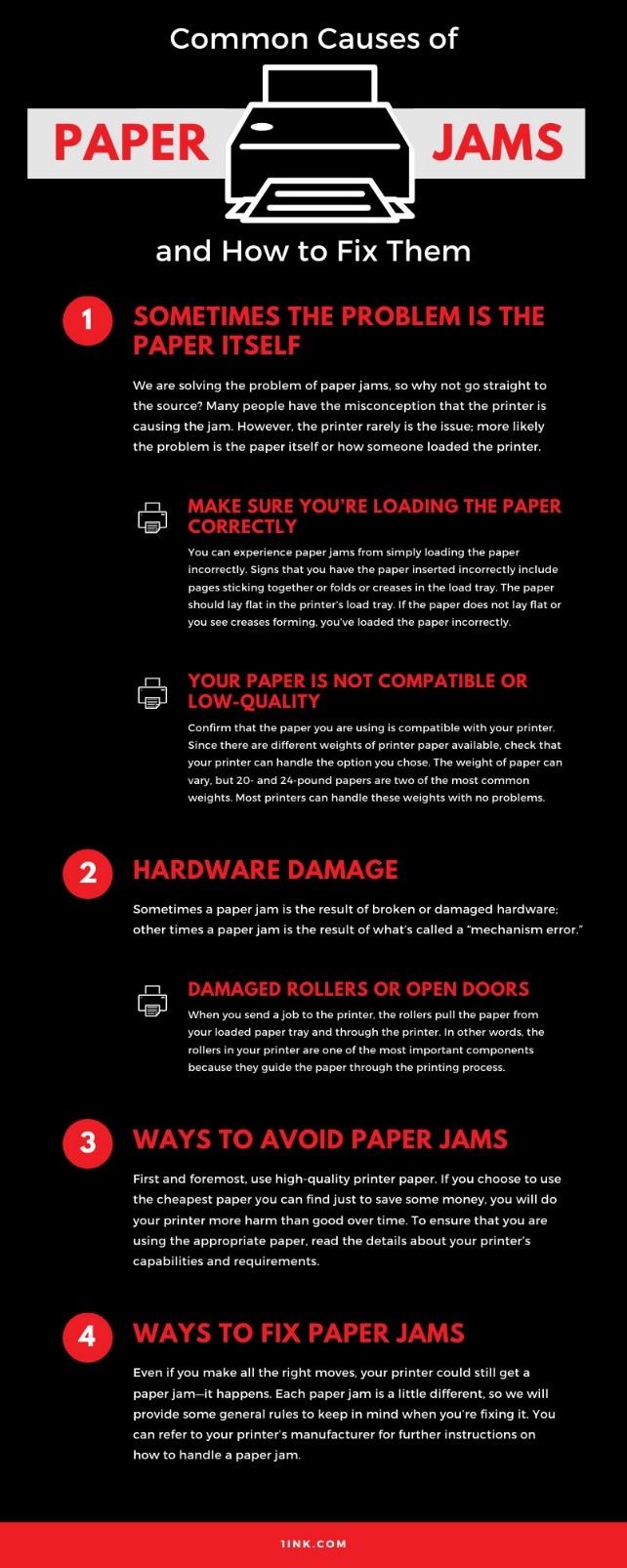
Paper jams are incredibly frustrating, especially if somebody left their jammed paper for you because they didn’t know how to fix it. Not only are paper jams annoying, but they’re also inefficient and wasteful. They damage the paper, so it’s no longer reusable, and paper is expensive. Every printer is prone to jams from time to time, but if you are experiencing them regularly, you should find out why. We break down some of the common causes of paper jams and how to fix them.
Sometimes the Problem Is the Paper Itself
We are solving the problem of paper jams, so why not go straight to the source? Many people have the misconception that the printer is causing the jam. However, the printer rarely is the issue; more likely, the problem is the paper itself or how someone loaded the printer.
Make Sure You’re Loading the Paper Correctly
You can experience paper jams from simply loading the paper incorrectly. Signs that you have the paper inserted incorrectly include pages sticking together or folds or creases in the load tray.
The paper should lay flat in the printer’s load tray. If it does not lay flat or you see creases forming, you’ve loaded the paper incorrectly.
Your Paper Is Not Compatible or Low-quality
Confirm that the paper you are using is compatible with your printer. Since there are different weights of printer paper available, check that your printer can handle the option you chose.
The weight of paper can vary, but 20- and 24-pound papers are two of the most common weights. Most printers can handle these weights with no problems. On the other hand, if you print with thicker paper, your printer may not be compatible or will require you to adjust the settings.
Check your printer’s compatibility settings. For example, if you print a lot of colored photographs that require thick and glossy paper, there may be a setting to accommodate this. In addition, if you print letterhead documents with nearly cardstock grade paper, you may need a different printer.
The paper’s quality can have a significant impact not only on the final product but on potential paper jams as well. Low-quality paper is usually thin, has imperfections, and can leave behind small particles of paper, referred to as “paper dust.”
Printers are rather precise machines, and if anything is slightly off, such as dust or particles of paper, you will likely see it in your printed documents. The particles might also signal an alert to the printer because it can interfere with sensors, resulting in a paper jam.

Hardware Damage
Sometimes a paper jam is the result of broken or damaged hardware; other times, a paper jam is a result of what’s called a “mechanism error.”
Damaged Rollers or Open Doors
When you send a job to the printer, the rollers pull the paper from your loaded paper tray and through the printer. In other words, the rollers in your printer are one of the most critical components because they guide the paper through the printing process.
Over time the rollers can wear down and become uneven. This makes pulling the paper more difficult on rollers and can result in an uneven pull, ultimately causing a paper jam.
Another common reason for paper jams is an open access door. Sometimes we open access doors to replace cartridges or remove paper jams. However, even if we think we closed the printer’s access door, if the sensor does not receive a closed signal, it can cause a paper jam.
Most printers nowadays come with sensors that prompt you to close an access door, and sometimes you can close the door enough for the signal to deactivate. However, once a print job starts, the movement of the printer can be enough to reactivate an access door open signal. If that happens, your printer will stop wherever it is in the process.

Ways to Avoid Paper Jams
First and foremost, use high-quality printer paper. If you choose to use the cheapest paper you can find just to save some money, you will do your printer more harm than good over time.
To ensure that you are using the appropriate paper, read the details about your printer’s capabilities and requirements. However, you cannot go wrong with a 20- or 24-pound papers, since these are industry average weights.
Most modern printers have settings that you can adjust according to weight, size, and type of paper. You may need to print with a less common type of paper from time to time, such as thicker paper for certificates or glossy paper for photos. Before you proceed with printing on different types of paper, check to see if your printer has options for those in its internal settings.
Another mistake some people make is loading different types of paper to the load tray at the same time, such as mixing weights. If you use different paperweights for the same print job, you will see inconsistencies because the printer expects the same type of paper during each print request.

Ways to Fix Paper Jams
Even if you make all the right moves, your printer could still get a paper jam—it happens. Each paper jam is a little different, so we will provide some general rules to keep in mind when you’re fixing it. You can refer to your printer’s manufacturer for more specific instructions on how to handle a paper jam.
First, turn the printer off before you begin fishing for the jammed paper. Electricity can be unpredictable, and you do not want any components moving around when you’re trying to fix the jam.
Next, when you see the paper causing the issue, do not start pulling on it because you’ll likely tear the paper and make your job more difficult. Instead, follow the paper through its natural path. For instance, if the rollers have already begun pulling the document, continue pulling the document through. Do not try to reverse the direction the paper was going.
Once you retrieve the jammed paper, close all the access doors, replace any items that you removed, and turn the printer back on. The printer will likely need to recalibrate once it has powered down—that’s completely normal.
Whether you’re a homeowner who occasionally prints or a business office that prints daily, there is a good chance you will experience a paper jam at some point. However, if you can recognize the common causes of paper jams, you will know how to fix them.
Whether you run a small business, work for a big corporation, or need to complete a school project, the task of printing should be as painless as possible. Along with smooth printing experience, you want to make sure you are using top-quality ink and toner cartridges to produce the best print results. But high-quality ink cartridges do not need to break your bank.
Here at 1ink, we believe people pay far too much for brand name ink cartridges, so we offer an affordable solution without sacrificing quality. Our remanufactured ink cartridges are eco-friendly and comparable to the brand name cartridges but sold at a fraction of the price. So if you’re looking for remanufactured Lexmark ink cartridges or any other major brand, we have an extensive inventory for you to shop.

